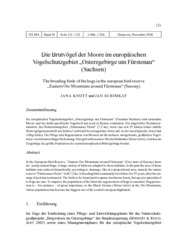Die Brutvögel der Moore im europäischen Vogelschutzgebiet „Osterzgebirge um Fürstenau“ (Sachsen)
Knott, Jana
Schmikat, Jan
36: 121 - 132
Knott, Jana; Schmikat, Jan, 2006: Die Brutvögel der Moore im europäischen Vogelschutzgebiet „Osterzgebirge um Fürstenau“ (Sachsen). In: TELMA - Berichte der Deutschen Gesellschaft für Moor- und Torfkunde, Band 36: 121 - 132, DOI: 10.23689/fidgeo-3041.
 |
Dokument öffnen: |
Abstract :
In the European Bird Reserve, “Eastern Ore Mountains around Fürstenau“ (Free state of Saxony) there are nearly natural bogs. A large variety of birds are adapted to these habitats. In the past the area of these habitats was reduced dramatically, according to drainage, like in a proportional area, namely the nature reserve “Fürstenauer Heide” with 7,2 ha. A breeding bird community lived there for 25 years, after the mining of peat has terminated. The birds to be found prefer sparse deciduous forest, but species specialiced to bogs are rare. To improve the population of the latter the regeneration of bogs is essential. Bog protection is – for instance – of great importance to the Black Grouse (Tetrao tetrix) in the Ore Mountains, whose population has become the biggest one of the central-european highlands. Zusammenfassung:
Im europäischen Vogelschutzgebiet „Osterzgebirge um Fürstenau“ (Freistaat Sachsen) sind naturnahe Moore und die dafür spezifische Vogelwelt nur noch in Resten vorhanden. Ein abgetorfter Hochmoorstandort, das Naturschutzgebiet „Fürstenauer Heide“ (7,2 ha), weist eine seit 25 Jahren relativ stabile Brutvogelgemeinschaft aus lichten Laubwald bevorzugenden Arten auf, in der moortypische Arten fast völlig fehlen. Die Pflege und Regeneration von Mooren ist für mehrere wertgebende, gefährdete Vogelarten von lebenswichtiger Bedeutung. Dies gilt insbesondere für das Birkhuhn (Tetrao tetrix), welches im Erzgebirge die größte Population der zentraleuropäischen Mittelgebirge besitzt.

